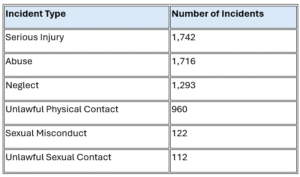A closer look at SIL profitability in 2022
August 24, 2022

Along with many of our readers, you might be shocked to discover the substantial variance in Supported Independent Living (SIL) profitability between providers. Perhaps you assumed that most providers converge on margins of only 2%, given the extremely rigid Disability Support Worker Cost Model (DSWCM).
We’re here to tell you that couldn’t be further from the case.
This article looks closely at the factors driving variation in profitability across the SIL market today.
What is the average margin for SIL providers?
Our benchmarking of the SIL market reveals that the average margin was 4.5%, with considerable variance (3.15% SD). Thereby demonstrating the opposite of reasonable expectations: provider profitability is higher than the cost model, and margins vary significantly.
Immediately this result seems strange. Since the DSWCM is benchmarked on the 25th percentile of efficient providers, surely the mean should be lower than 2%. But, as it turns out, there are far more areas to influence SIL margins than you might expect. Unsurprisingly, some aspects of the DSWCM are potentially overstated in the data supplied to the NDIA.
The low-hanging fruit
Vacancies
While unlikely to come as a surprise, our data proves that vacancies are a core determinant of SIL profitability.
Here are two reasons why:
Vacancy rates vary significantly between providers.
While the average vacancy rate in our benchmarking dataset is 8%, this figure varies wildly between providers. Smaller providers, or those specialising in 1-on-1 support, are often able to eliminate vacancies, while larger providers have reported rates as high as 20%.
Vacancies can generate substantial losses.
Our modelling suggests that when operating against the standard DSWCM, a 20% vacancy rate will result in at least a 15% loss on the SIL program.
Billable time
For providers with low vacancy rates, billable hours also vary considerably and can impact profitability through unmatched hours and utilisation rate.
Firstly, providers yet to match their SIL roster to their payroll often incur leakage, where staff working hours aren’t being matched to billable hours. Just one single unbilled hour per week can impact a provider’s margins by 10%, which is massive over an extensive SIL program.
A provider’s utilisation rate is also relevant to note. Utilisation consists of breaks, training, and ‘other’. This DSWCM assumes that 8% of a support workers time is non-billable, but our benchmarking dataset indicates this figure is closer to 4.5%. We have also seen cases where this figure approaches 2%. Given that this is $4 p/h at the 8% level, significant margins accrue when this is optimised.
Billable time reflects a major trend in our analysis. Providers are typically overspending on indirect expenses (overheads) and making savings in frontline costs, especially utilisation and as you’ll see later in the article, sleepover rates. We’ve consolidated these components into effects on the expected 2% margin.
Area | Optimised | Unmanaged |
Vacancies | 0% | -690% |
Roster leakage | 0% | -10% |
Utilisation | 185% | 0% |
*Note: The above percentages are large as the baseline margin is 2%
As you can see, leakage and vacancies can destroy margins, but considering the DSWCM assumes 0% vacancies or leakage, there is no upside on assumed margins. However, maximisation of the utilisation rate (i.e., reducing frontline staff training and meetings) has a substantial impact on margin. Curiously, we often find that utilisation isn’t managed and is often left for supervisors to manage at their discretion. As a result, providers that develop metrics and pay close attention to this number can find a sweet spot in employee satisfaction and margin. However, utilisation rate maximisation has several trade-offs that providers must consider cautiously.
The edges: span of control and overheads
Eager observers will note that the NDIS has recently changed its DSWCM methodology. We used to observe their expectations for ‘non-frontline’ overhead, roughly 10.5% of revenue. However, they have now consolidated this into a single category. This change is of no concern to our readers as we have been tracking individual overhead benchmarks for nearly a year, and it won’t surprise you that there is tremendous variation between providers.
A curious note: we’ve recently seen major private providers publicly condemn individual contractors for receiving the overhead component. They argue that ‘big providers’ have to manage ‘complex systems’, which means they should accrue larger payments from their customers.
In our opinion, this argument is frankly absurd as it assumes that smaller providers aren’t responding to complexity. Instead, we see that smaller providers usually have a few individuals managing a portfolio of probity, risk, HR, and finance. Indeed, the opposite appears to be true. It is incumbent on larger providers to improve their overhead efficiency to keep up with smaller providers who engage directly with the customer, eliminating most managerial duplication. We’ll unravel just how much these systems affect margin.
Overheads
The original DSWCM had overheads at 10.5% of revenue. Interestingly, our dataset puts the mean at 15%, with a limited variation of 3%. This number clusters higher, given the methodology used in the pricing survey, which appears to be generated by entity rather than customer volume, is unsurprising.
We’ve seen larger providers achieve 7%, generated by robust hiring automation, efficient IT systems, and an obsession with maximising their CAC (customer acquisition cost) to ensure that marketing expense was going where it counts. However, if you’re reading this from within a major organisation, you may notice that hiring automation and CAC are rarely mentioned.
Other providers have taken a different approach. For example, we’re aware of at least one case where the majority of ‘back office’ functions are outsourced, which hinges on a technical and competent executive team that can manage their service level agreements (SLAs) and expertly handle any question outputs from the organisation. This organisation unsurprisingly has healthy margins, which is at least in part due to its executives having strong commercial backgrounds. But, of course, this often means not being able to trot down to payroll to address an issue raised by a team member or adjust financials an hour before a board meeting.
In new articles to come, we will release benchmarking data for the cost of each major overhead department, including variance. But, again, it won’t surprise our readers that HR and IT dominate the variation in this space, with radically different approaches to cost and outcomes.
Spans of control
Another significant area of variability is supervision spans of control (SoC), or how many staff a supervisor oversees. The DSWCM puts this at 15 FTE, with a supervisor at an assumed SCHADS level of 3.2. Again, you won’t be surprised to see enormous variation here, ranging from a SCHADS level 3.1 with a span of 20 FTE to a SCHADS level 5 with spans of 10 FTE.
The supervisory structure is often an afterthought in the NDIS, and our view is it offers some profitability optimisation. Still, it is loaded with significant trade-offs regarding employee engagement. Although again, we share the views of Bigby and Beadle-Brown, if you can get this right, you can substantially lower turnover and signal promotional opportunities to frontline staff who are often development starved.
A look at possible margin increases:
Area | Optimised | Unmanaged |
Vacancies | 0% | -690% |
Roster leakage | 0% | -10% |
Utilisation | 185% | 0% |
Overheads | 268% | -189.50% |
SoC | 44% | 58% |
Overhead efficiencies can substantially increase margins and, on average, have a harmful effect if allowed to propagate unchecked. Our view is that this is where large providers come undone, as political factions emerge where labour isn’t directly measurable or attributable to customer outcomes.
The most potent cure for these situations is robust SLAs between departments, benchmarked against deliverables and sector-wide value. But unfortunately, many in our sector are unprepared for these challenging conversations.
The elephant in the room
Of course, a significant driver of SIL profitability is the sleepover arrangement. While this allows staff to wake up at least once, many providers have stabilised clientele who do not require assistance at night.
Indeed, the margin difference between an active overnight program (2%) and an undisturbed sleepover (7%) is extreme and is often the sole determinant of program profitability. Typically, providers with a large volume of active overnight programs have been forced to find efficiencies in other parts of their programs.
The wash up
In some SIL settings, if efficient systems and governance structures are in place, it is possible to achieve margins of 16%. However, this may come at the detriment of staff and customers. While we don’t advise pursuing this margin, we encourage providers to benchmark themselves against each element of the DSWCM and the sector to see where they can generate more value or stability in their programs.
Many of our readers operate as not-for-profit organisations, where margin is seldom discussed. Our view, however, is that an efficient not-for-profit that adds additional value to its staff can solve the turnover problem and its associated growth issues.
In some SIL settings where efficient systems and governance structures are in place, it is possible to achieve margins of 16%. However, this may come at the detriment of staff and customers. So while we don’t advise pursuing this margin, we encourage providers to benchmark themselves against each element of the DSWCM and the sector to see where they can generate more value or stability in their programs.
Many of our readers operate as not-for-profit organisations, where margin is seldom discussed. Our view, however, is that an efficient not-for-profit that adds additional value to its staff can solve the turnover problem and its associated growth issues.
At Empathia Group, we help you overcome your biggest headaches regarding Supported Independent Living (SIL), such as vacancy rates, billable time, funding changes, and competition increases. We assist you in forecasting your growth and anticipate the additional requirements and costs for serving new clients in new ways.
Interested in learning how your organisation is managing in the current market? Take our free SIL Viability Assessment
If we can help you achieve your business goals, please reach out.
Share this article:
Continue reading Empathia Insights
Kafkaesque: The Moral Hazard at the Heart of SIL
Kafkaesque: The Moral Hazard at the Heart of SIL Dean Bowman November 18, 2025 Supported Independent Living The Federal Court's...


